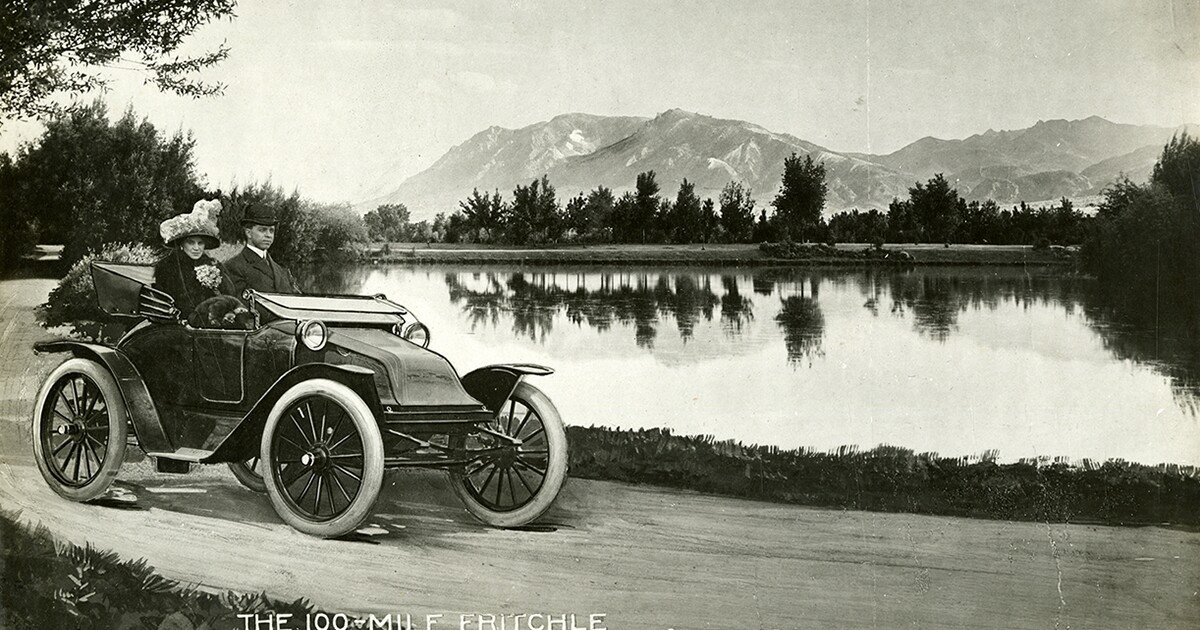In the early 1900s, it wasn’t quite clear how automobiles would evolve. There were numerous inventors and companies pinning their fortunes on how we’d get around—whether by steam, gasoline, or, yes, even electric cars. Rachael Storm, associate curator of business and industry at History Colorado in Denver, says that in the early 20th century, electric vehicles were about 38 percent, steam about 40 percent, and gasoline only around 22 percent of cars.
The museum has one of those vintage vehicles in its collections—the “100-Mile Electric” made by Oliver P. Fritchle in 1910. Fritchle built his sedan himself—from its axle and motor to its chassis and body. The cars were agile and could even go up into the Rockies, recharging themselves as they coasted downhill.
For its day, a 100-mile range was remarkable, as was Fritchle’s foresight to, like the Tesla company today, develop his own battery and charger first—before designing the vehicle. Another thing he did that was brilliant? He marketed his cars to women.
Storm says that Fritchle found his primary demographic with wealthy Denver women, including the “unsinkable Molly Brown,” who survived the Titanic disaster and returned to Denver as a philanthropist. “People would see her driving around Denver in her Fritchle, driving a model called the ‘phaeton’ that he marketed to women,” Storm says. It was “an open carriage type design. There’s no top to it. It’s kind of the early convertible.”

courtesy of History Colorado
The Fritchle auto’s appeal to wealthy women was not only its elegance but also that it could be charged at home and was clean. “If you ever watch an old movie, they have the crank on the front of the car. That’s a gas car. You had to crank it to get it started.” Those gasoline cars created giant plumes of smoke that would soil ladies’ dresses, so Fritchle offered women a non-polluting alternative.
Ahead of His Time
Fritchle had a good run that ended when Ford developed the electric starter, which eliminated the need for a crank. Plus, Ford’s Model Ts were far cheaper—$500 versus Fritichle’s cars, which sold for over $2,000.
Still, he was ahead of his time by offering clean cars to women. Women today like Erika Myers, the executive director of CharIn North America, an organization focused on standardizing charging infrastructure, who drives an electric car, says, “I don’t miss the gas station at all. I don’t miss touching those grubby handles that are disgusting and never get cleaned. I don’t miss the fumes coming out of the gas station. I don’t miss the time that I had to spend filling my car or changing my oil. The EV has made my life infinitely better, and I will never go back.”
Myers has a blog called EV Love encouraging women to buy electric vehicles, which she acknowledges is a challenge. Despite making over 80 percent of the vehicle purchasing decisions for their families, women are not taking the plunge. According to research from Edmunds, “U.S. auto sales data confirms there is a gender gap in electric vehicle purchases even as the segment grows in market share and popularity among consumers. In 2023 (through June), 67 percent of all EV buyers were men and 33 percent were women.”
Where’s the Minivan?
So, what’s stopping women from going electric? Myers says it’s the way that vehicles, especially EVs, have been marketed. “It’s a lot of things that women don’t necessarily care about, the zero to 60 speed…We’re not really looking for something like a roadster. We’re not looking to drag race.” Early adopters of EVs have been techie types, mostly men, driving cars designed by and for them. Women with families who might want to go electric for environmental and climate reasons didn’t really have appealing options.
One solution, Myers says, is to get more women engineers working at automakers to influence the design and to have more women in leadership positions, but she recognizes that could take a while. She says what’s missing currently is a fully electric minivan, and Loren McDonald, the CEO and founder of EV adoption, an electric vehicle data analysis firm, says it’s a market that an automaker could have owned. Think about it, he says: moms take the kids to soccer, to the doctor, to school. Minivans are easier to get in and out of, especially when you have to juggle youngsters and car seats.
McDonald thinks that fundamentally manufacturers missed the boat on designing EVs for the part of the market that is buying the car and making the decision. They didn’t design EVs that would fit with what women were looking for. “They [women] think about safety, comfort, practicality, pricing, and monthly payments.”
A Red Flag
If there’s a red flag for EV adoption by women, it’s the charging infrastructure. According to research by Geotab Inc., a technology company that provides vehicle and asset tracking solutions, safety at public charging stations is a big factor among women considering an electric vehicle in Canada and the U.S.
In the U.S., they found that:
- 43 percent of women surveyed have safety concerns regarding EV charging stations.
- approximately 40 percent of women surveyed noted the importance of accessible, well-lit charging stations in less remote areas would influence their EV purchase decision.
- 21 percent of women surveyed consider increased security around charging stations as a factor that could influence their next vehicle purchase.
Myers has seen this in her own research and McDonald says, even as a man, he has felt uncomfortable at isolated charging stations. “Most of these, not all, but a lot of these chargers are literally located in some far corner of a shopping mall parking lot or behind a restaurant where there’s little to no lighting and where it’s unsafe,” Myers says until there are safe charging locations, she doesn’t think we’re going to get a lot of traction from females. “My concern is that we don’t get in a situation where EVs are deemed as unfriendly for women.”
Raise Your Hand If You Know What “Octane” Means
Making things more challenging—for both women and men—is the unfamiliar lexicon of “dozens and dozens of types of chargers and power levels and compatibility and connectors and terminology” that drivers need to learn, says McDonald. If you go to a gas station, he adds, you probably don’t think about what “octane” means on the pump. You don’t need to. You just know that your car takes regular or supreme. Easy. If charging EVs sounds too complicated, he says people are just going to stick with gas cars.
As discouraging as this sounds for getting off fossil fuels, there are many reasons to be hopeful. First, several minivans are on the way from Volvo, Honda, and Volkswagen, among others.
Second, charging EVs should soon get a lot easier—and safer. “The automakers basically punted on solving the single biggest hurdle to transitioning from a gas-powered car to electric, which is solving the refueling problem,” McDonald says. That issue could soon be remedied as Tesla announced that it is opening up its superchargers to rivals, doubling the number of fast chargers available to the public. Also, seven automakers, including BMW, General Motors, Honda, Hyundai, Kia, Mercedes-Benz, and Stellantis, formed a new company called IONNA, and announced on February 9, 2024, that they are building out their own charging network.
Last but certainly not least, government and utilities are providing incentives for convenience stores to host chargers, which would give drivers amenities like bathrooms, food, and Wi-Fi while they charge. The gas station/food stop business is already declining, not because of EVs, but because of hybrids, McDonald says. “Cars are just becoming more efficient so you can go farther before you need to fill up. But they know EVs are coming. It’s just a matter of when.”
While adoption could soon accelerate, Myers says, “I’m not very good at being patient. It feels like all this stuff should have happened yesterday. But I have to remind myself we’re in the biggest transportation transition of the last century. And just by nature, there’s a lot of hurdles we have to overcome.”
Indeed, a century after Fritchle made his electric car, we’re at another inflection point for automobiles. Keep driving dirty gas cars, or follow his lead and make EVs attractive to women. It’s a move that could help put climate change in the rearview mirror.
This story was shared with KSUT via Rocky Mountain Community Radio, a network of public media stations in Colorado, Wyoming, Utah, and New Mexico, including KSUT.
© H2O Media, Ltd.


